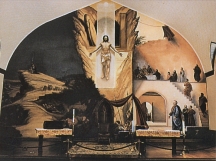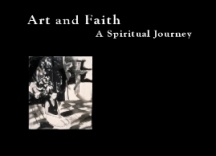| | | | | | | | | | 
The Ben Long fresco for St. Peter's Catholic Church, Charlotte, NC.
Photo from the book Wet-Wall Tattoos: Ben Long and the Art of Fresco by Richard Maschal. | | | | When Things Go Wrong
Ever have one of those days when things will just not go right?
When a writer is faced with a blank page and the task of putting words together with a mind that does not want to cooperate it is called writer's block. But artists can face the same problem with a blank canvas. Just getting started can be a difficult task. Then there is the problem when the image that is developing on the canvas does not match the image visualized in the mind. Examples are many where even great artists have painted over sections of canvas that did not suit them, or simply painted a different image on the back of a canvas.
Then there are the times when a work of art has been completed, installed in a place of distinction, and something really goes wrong.
Ben Long has made a career as a teacher and a painter of frescos. He has created stunning frescos in North Carolina for Holy Trinity Episcopal Church in Glendale Springs, St. Mary's Episcopal Church in West Jefferson, The Chapel of the Prodigal at Montreat College, and at St. Paul's Episcopal Church in Wilkesboro.
Beginning in 1988, Ben Long spent two years creating a very large fresco for historic St. Peter's Catholic Church in Charlotte, North Carolina. Over 1500 square feet and 30 feet high, the fresco depicted "The Agony in the Garden", "The Pentecost", and at the center "The Resurrection". Richard Maschal documented the creation of this incredible work of art in the book "Wet Wall Tattoos: Ben Long and the Art of Fresco".
Then in 2002, the unthinkable happened. The entire center section of the fresco crashed to the floor with remaining areas severely damaged. A heart breaking disaster. While it would be determined that numerous construction projects in the immediate area surrounding the historic downtown church was the cause of the destruction – with the foundation work on a high-rise bank building next door delivering the final blow – the lost was still devastating.
The creation of art can be difficult and often frustrating work. To render an object that reflects one's thoughts, vision, and passion, can be exhilarating. The late folk artist Sybil Gibson once said, "I have had so many adversities related to my painting – along with some notable successes – that I sometimes wonder at my determined drive to keep trying in the face of some of my disasters. Everything one creates doesn't turn out a masterpiece, but it is such a joyous thrill to bring off something you recognize as being good from your innermost self."
Dan Hardison
Editor, The Episcopal Church and Visual Arts
editor@ecva.org | |


